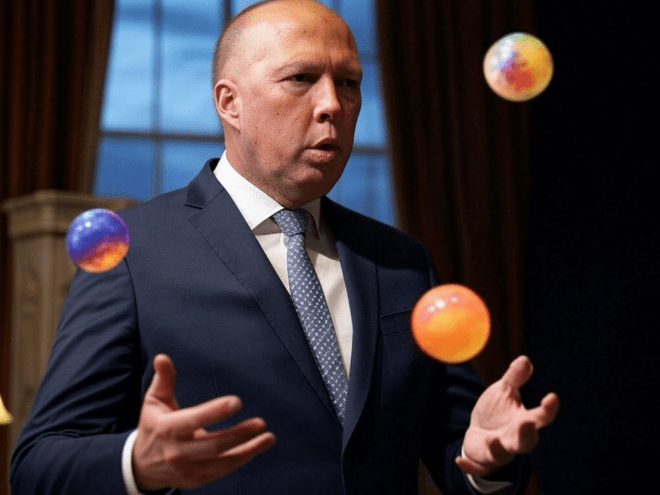
“Repetition does not transform a lie into a truth”
~Franklin D. Roosevelt~
Introduction
As Australia gears up for the federal election on May 3, 2025, the political landscape is heating up with fervent debates and intense campaigning. The Liberal Party, led by Peter Dutton, has adopted a strategy that capitalises on economic grievances, cost-of-living concerns, and sharp critiques of the incumbent Labor government, headed by Anthony Albanese. However, a closer examination reveals that many of the Liberal Party’s assertions are riddled with misinformation and exaggeration, raising significant ethical questions about political campaigning in a democratic society.
This post delves into the misleading claims propagated by the Liberal Party, as highlighted by AAP FactCheck and other reputable sources. It aims to unpack the implications of these narratives for public trust, policy discourse, and the overall integrity of Australia’s democracy. By scrutinising the evidence from the 2025 campaign trail, we argue that while misinformation is not exclusive to any single political entity, the Liberal Party’s reliance on debunked claims under Dutton’s leadership signifies a troubling trend of prioritising electoral advantage over factual accuracy.
Section 1: The Inflation Myth
One of the most prominent claims made by the Liberal Party is that the Labor government has presided over “world-leading inflation rates,” thrusting Australians into economic turmoil since their election in May 2022. This assertion, amplified through campaign advertisements, paints a bleak picture of Labor’s economic management. However, economists consulted by AAP FactCheck have categorically debunked this narrative, demonstrating that Australia’s inflation rates have consistently been lower than those of many advanced economies, including G7 nations, during Labor’s tenure. Furthermore, the cumulative price growth in Australia since the global inflationary surge triggered by the COVID-19 pandemic has been described as “middle of the pack” in comparison to peer economies.
The Liberal Party’s inflation claim is not merely an exaggeration; it is a deliberate distortion aimed at amplifying voter dissatisfaction. Inflation is a complex global issue influenced by numerous factors, including supply chain disruptions and energy prices, and cannot be solely attributed to domestic policy decisions. By framing Labor as uniquely responsible for high inflation, the Liberals conveniently sidestep the broader economic context, including the role of the Reserve Bank of Australia’s monetary policies and international economic pressures. This fairytale serves a clear political purpose: to undermine confidence in Labor’s economic credentials while positioning the Liberals as the answer to cost-of-living concerns. The persistence of this debunked claim, despite expert refutations, underscores a willingness to prioritise electoral gain over truth.
Section 2: Migration and the Electoral Roll Scare
Migration has emerged as another cornerstone of the Liberal Party’s campaign, with Dutton alleging that Labor’s policies have led to unsustainable population growth, thereby straining housing and infrastructure. A particularly alarming claim suggests that migrants arriving since 2022 are responsible for a 710,000-person expansion in Australia’s electoral roll, insinuating an undue influence on the democratic process. However, AAP FactCheck has decisively debunked this narrative, clarifying that migrants who arrived under the Albanese government are ineligible to vote. To gain citizenship – and thus voting rights – a person must have resided in Australia on a valid visa for a minimum of four years, meaning that any recent arrivals would have entered under the previous Coalition government or earlier.
Dutton’s broader assertion that 1.8 million migrants will arrive over the next five years further exemplifies the Liberal Party’s selective storytelling. Experts note that this figure omits critical context, such as the impact of Coalition-era visa policies that reduced migrant departures post-COVID, contributing to higher net migration. By framing migration as a crisis induced by Labor, the Liberals tap into public anxieties about housing affordability and urban congestion, all while neglecting their own policy contributions to the issue. This fairytale not only misrepresents the impact of migration but also risks inflaming social tensions by scapegoating newcomers, a tactic reminiscent of divisive strategies seen in other global populist campaigns.
Section 3: The Energy Policy Mirage
Energy policy has become a battleground in the 2025 election, with the Liberal Party promoting its nuclear power plan as a panacea for rising electricity costs and emissions targets. Dutton has repeatedly claimed that Labor’s energy strategy is “renewables-only,” suggesting it leads to unreliable and expensive power. However, AAP FactCheck has labeled this assertion false, emphasising that Labor’s plan includes a significant role for gas generation through 2050 and beyond, especially during periods of low renewable output, such as winter months. The Liberal Party’s insistence on this misleading narrative ignores the nuanced reality of Labor’s mixed-energy approach, which seeks to balance renewables with gas to ensure grid stability.
The Coalition’s nuclear proposal, estimated by Dutton to cost $330 billion, has also been mired in controversy. Critics, including energy experts, argue that this figure is highly unreliable, with costs likely to escalate due to the complexities of nuclear development in a country lacking existing infrastructure. Labor’s counterclaim that the plan would cost $600 billion, while also criticised as speculative, reflects the broader uncertainty surrounding the feasibility of nuclear power in Australia. Dutton’s reluctance to emphasise nuclear power in later stages of the campaign indicates an awareness of its unpopularity among voters who are wary of long timelines and safety concerns. By misrepresenting Labor’s energy policy and downplaying the challenges associated with their own, the Liberals have spun a fairytale that oversimplifies Australia’s energy transition, potentially misleading voters about the necessary trade-offs involved.
Section 4: Vehicle Emissions Standards and the Toyota RAV4 Fiction
Dutton’s campaign has also targeted Labor’s vehicle efficiency standards, alleging that they would significantly increase the cost of popular vehicles like the Toyota RAV4. On April 6, 2025, Dutton reiterated this claim, suggesting that Labor’s emissions policies would burden families with higher car prices. However, AAP FactCheck has debunked this assertion, finding no evidence to support the Liberal Party’s cost projections. Labor’s standards, which were legislated after consultation with the automotive industry, aim to incentivise cleaner vehicles without imposing prohibitive costs on consumers. Dutton’s narrative neglects these details, instead exploiting public fears about affordability to portray Labor as anti-motorist.
The Liberal Party’s decision to retain the efficiency standards while abolishing penalties for non-compliance further complicates their position. This policy shift, announced during the campaign, contradicts their earlier rhetoric about protecting consumers from Labor’s “tax on family cars and utes.” By simultaneously criticising Labor’s standards and promising to dilute them, the Liberals have crafted a fairytale that lacks coherence, relying on voter distrust rather than offering a clear alternative. This tactic risks alienating environmentally conscious voters while failing to provide meaningful relief to those concerned about vehicle costs.
Section 5: The Housing Policy Vacuum
Housing affordability has emerged as a key issue in the 2025 election, with both major parties unveiling policies aimed at addressing the crisis. Dutton’s claim, made on April 6, 2025, that “no homes have been built under a Labor government policy,” was swiftly debunked by AAP FactCheck. While Labor’s housing initiatives, such as the Help to Buy scheme, have encountered delays, progress has been made, with funding allocated and construction underway in certain regions. Dutton’s assertion erases these efforts, presenting a black-and-white narrative that overlooks the complexities of housing delivery, including the roles of state governments and market constraints.
The Liberal Party’s own housing policy, which centres on tax deductions for first home buyers purchasing new homes, has drawn skepticism from economists who warn that it could inflate prices by boosting demand without addressing supply. Dutton’s promise to “restore the dream of home ownership” hinges on measures like cutting migration and unlocking land, yet lacks detailed costings or timelines. By exaggerating Labor’s shortcomings and overselling their own solutions, the Liberals have spun a fairytale that resonates emotionally but falters under scrutiny, potentially leaving voters disillusioned when promises fail to materialise.
Section 6: The Broader Implications of Misinformation
The Liberal Party’s reliance on debunked claims reflects a broader trend in modern political campaigning: the prioritisation of narrative over evidence. Dutton’s strategy, which mirrors tactics employed by populist figures like Donald Trump and Boris Johnson, targets suburban voters with emotive issues such as cost of living and housing, often at the expense of accuracy. This approach risks eroding public trust in institutions, as voters become increasingly skeptical of both political rhetoric and the media tasked with fact-checking it. The persistence of false claims, even after being debunked, suggests a calculated gamble that repetition will outweigh corrections in shaping public perception.
Moreover, the Liberal Party’s fairytales have social consequences. By framing migration as a threat or renewables as a failure, the campaign amplifies division and distracts from collaborative policy solutions. The electoral roll scare, for example, fuels xenophobia, while the energy policy mirage undermines bipartisan efforts toward achieving net-zero emissions. These narratives not only mislead voters but also complicate the post-election landscape, where cooperation will be essential in addressing Australia’s challenges.
Section 7: Countering the Fairytales
Combating misinformation requires a multifaceted approach. Fact-checking organisations like AAP play a crucial role, but their reach is limited compared to the vast budgets allocated for political advertising. Media outlets must prioritise clarity over sensationalism, presenting corrections in ways that resonate with audiences. Voters, too, have a responsibility to seek out reliable sources and question simplistic narratives. Political parties must also face stronger accountability for disseminating falsehoods, whether through electoral regulations or public pressure.
Labor’s own missteps, such as Albanese’s inflated nuclear cost estimate, serve as a reminder that no party is immune to exaggeration. However, the Liberal Party’s pattern of debunked claims under Dutton’s leadership stands out for its consistency and scale. Addressing this issue necessitates not only exposing lies but also fostering a political culture that rewards honesty over hyperbole.
Conclusion
The Liberal Party’s 2025 election campaign, led by Peter Dutton, has leaned heavily on fairytales that crumble under scrutiny. From the debunked inflation myth to false narratives surrounding migration, energy, vehicle costs, and housing, these claims reveal a strategy rooted in fear rather than facts. While such misinformation may effectively capture attention, it ultimately undermines democratic trust and distorts critical policy debates. As Australia approaches the May 3 election, voters must navigate this complex landscape with skepticism, demanding clarity and accountability from all political entities. The Liberal Party’s fairytales may enchant some, but their unraveling serves as a poignant reminder that truth, not fiction, should guide the nation’s future.
References
• Liberal Party of Australia. (2025). Getting Australia Back on Track.
• ABC News. (2025). Dutton makes case to become PM, rallying Liberal faithful at launch.
• The Guardian. (2025). Afternoon Update Election 2025: Labor’s clean car policy in the crosshairs.
• ABC News. (2025). Federal election 2025: Plibersek laughs off exchange with Albanese.
• InDaily. (2025). Liberals’ anti-Labor inflation claim debunked.
• AAP. (2025). Experts debunk Liberal’s inflation claim against Labor.
• The Conversation. (2025). Can Peter Dutton flip Labor voters to rewrite electoral history?
• AAP. (2025). Albanese, Dutton parrot debunked claims in election debate.

